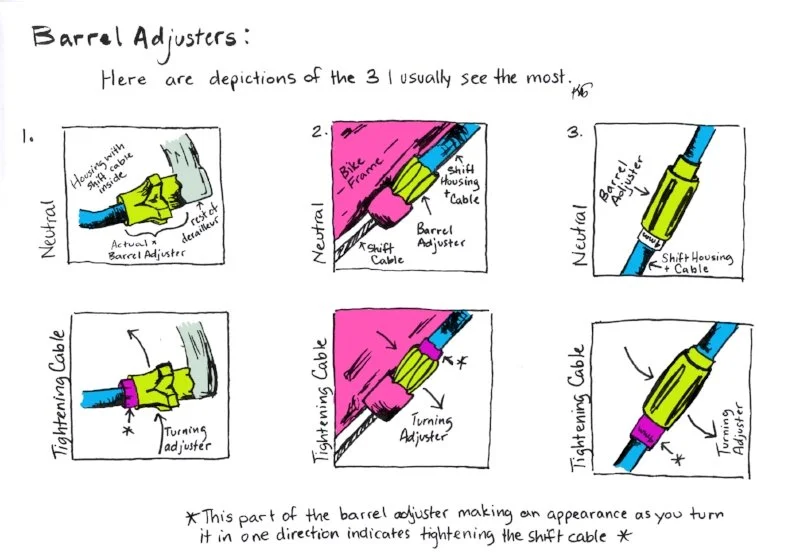THE EASIEST BIKE FIX WE’D TEACH EVERY RIDER IF WE COULD
visiting a bike shop can help you determine if your derailleur hanger, limit screws or other issues are at play
one of the most common reasons people come to the bike shop is because they are having issues with their shifting.
specifically, the bike is hesitating to shift into easier gears — maybe it takes two or three throws of the thumb at the shifter before the derailleur really moves at all!
if everything else is in order (a clean, unworn chain and drive train, correct chain length, and a straight derailleur hanger) then there’s a good chance you can fix this yourself using your barrel adjusters.
a derailleur that isn’t moving easily up the cogs of the cassette (into easier gears) is likely the symptom of too little cable tension.
shift cables stretch over time, so especially if you’re on a new bike or a bike with recently replaced cables, then this trick can save you a trip to the bike shop (though we do love seeing you and having the opportunity to share more tips in person and check in on how your at-home bike maintenance is going).
barrel adjusters are intended for fine-tuning your cable tension. they allow you to make small adjustments without having to completely disconnect the cable from the derailleur pinch bolt.
for some people this is an entirely new concept, so let’s step back a bit. What is a barrel adjuster?
A barrel adjuster typically consists of a small cylinder with a threaded end that can be rotated to either tighten or loosen the cable tension.
you will find it where your shift cable enters your shifter. They can also be found “in line” along the housing (more common in road bikes) or where the shift cable enters the rear derailleur. cable actuated dropper posts such as the oneup dropper also have barell adjusters at the lever.
Thanks to Kelly Paduch at rocktown bicycles in virgina for these helpful sketches
To use a barrel adjuster to fix cable tension, follow these steps:
Shift the gears to the smallest cog at the rear and then observe the movement of the DERAILLEUR and chain as you shift through the gears back into the easiest cog.
if the chain is struggling to move up the cassette into easier gears, it’s likely because there is not enough cable tension. if the chain is struggling to move down the gears into harder, smaller cogs, it is likely a symptom of too much cable tension.
Locate the barrel adjuster. It is usually located at the cable exit point on the shifter, the entrance point of the cable to the rear derailleur, or in line along the housing, near the front of the bike.
Turn the barrel adjuster counterclockwise to release cable tension.
for barrel adjusters at the shifter, an easy way to remember which direction to turn your barrel adjuster is:
-turning the barrel forward, away from the bike tightens the cable and help the chain move up the cogs.
-Turning the barrel toward the rider or toward the bike helps the chain move down the cogs.For Barrel adjusters at the rear derailleur an easy was to remember the direction to turn is:
-If the derailleur is hesitating when shifting toward the wheel, turning the barrel toward the wheel will ASSIST the chain in that direction
-and if it hesitates shifting away from the wheel, turn the adjuster away from the wheel/bike.turn the barrel adjuster one quarter turn at a time.
Shift the gears to the smallest cog on the cassette and then shift back through each gear, observing the chain movement to the largest cog and back down to the smallest.
fine-tune the barrel adjuster until the gears are indexing smoothly.
here’s you can see a dirty chain and cassette, as well as the DERAILLEUR hanger - it’s essential your derailleur hanger is straight, cable and housing are in good shape and that the drivetrain is clean in order for the chain to move smoothly.
while this all sounds pretty easy to do, it depends on what condition your drivetrain is in as to whther this quick fox will work for you. if cable and housing are old or dirty, there can be a lot of friction in the system that impacts howm freely the derailleur is actuated by the cable.
Even a slightly bent derailleur hanger can severely impact the movement of your derailleur and should be repaired immediately by a professional to prevent serious damage on the trail (such as your derailleur shifting over the largest cog and destroying your wheel).
If the drivetrain is dirty, the chain is worn or the limits and b-tension of the derailleur are not correct - the repair work needed goes beyond cable tension and you should DEFINITELY visit a bike shop.
At dialed we will check your hanger for alignments, check your chain for wear, check your cable and housing for integrity and ensure all of the limits and tension settings are correct.
but once everything is clean and aligned, you’re set up to make these micro adjustments at home and on the trail by yourself and without any tools.



